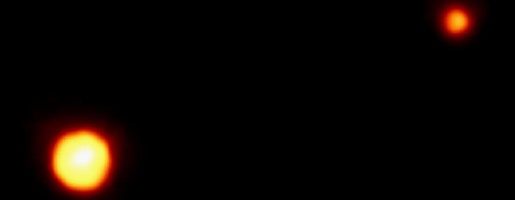 |
|
|
Hubble
Space Telescope image of Pluto (left) and Charon.
|
|
| PLUTO- THE SMALLEST PLANET | |
| Pluto, orbiting at the edge of the Solar System, is sometimes not even regarded as a proper planet. Pluto is even smaller than our Moon and has more in common with the icy satellites than the inner planets of the Solar System. Pluto is in fact the smallest planet in the Solar System. Some people have even called for it to be classified as an asteroid, but its status as a planet is assured. | |
| Over the last 20 years our understanding of Pluto has improved a great deal, though our knowledge of its surface characteristics, composition and evolution remain little more than conjecture. Every planet has been visited by spacecraft - except Pluto. Consequently, Pluto remains faint, remote, and mostly unknown, appropriate for a planet named for the Roman god of the underworld. | |
| An eccentric orbit | |
| Pluto orbits the outer edge of the Solar System at an average distance of 5,914 million kilometres. Pluto's orbit has the highest orbital eccentricity of the planets (0.25). | |
| Therefore there is a large difference between the aphelion and perihelion distances. Aphelion distance is 7,345 million kilometres, and perihelion distance is 4,410 million kilometres, a difference of 2,935 million kilometres. | |
| Although Pluto is usually the outermost planet, its high orbital eccentricity means that its orbit overlaps Neptune's - during its 249 year orbit Pluto spends about twenty years within the orbit of Neptune. Between 21st January 1979 and 14th March 1999 Neptune was the farthest planet from the Sun. Pluto has now returned to its role as the most distant planet of the Solar System. | |
| The orbit of Pluto is also unusual in that it is highly inclined (17o) to the plane of the Solar System. Although Pluto crosses the orbit of Neptune regularly, this high inclination prevents a collision. In fact, Pluto gets closer to Uranus than to Neptune. Furthermore, Pluto exhibits retrograde rotation - it rotates on its axis in the opposite direction to the other planets, and has its rotation axis tilted at 122o to its orbital plane. | |
| Pluto's orbital characteristics make it seem as though Pluto is not a planet. By now Pluto should have been thrown out of the Solar System by the gravitational forces of the other planets. This has not occurred as Pluto is locked into a 3:2 resonance with Neptune - Pluto's orbital period is exactly 50% longer than Neptune's. The 3:2 resonance means that Pluto completes two revolutions around the Sun for every three completed by Neptune. | |
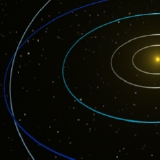 Pluto's eccentric orbit. |
|
| The smallest planet | |
| Pluto is the smallest planet in the Solar System - seven other moons in the Solar System are larger than Pluto. The small size of Pluto (a diameter of only 2304 kilometres), coupled with its eccentric orbit, has lead some astronomers to request that Pluto be demoted from being a planet to an asteroid. | |
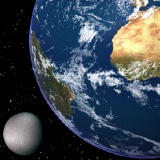 Comparison between Earth and Pluto. |
|
| Magnetic field | |
| No magnetic field has been detected. | |
| Atmosphere | |
| An atmosphere has been detected on Pluto, but with a pressure of only 3 microbars (3 millionths of a bar). Pluto's atmospheric pressure is 3 thousand millionths the pressure of Earth's atmosphere. The atmosphere consists of methane (CH4), and nitrogen (N2). | |
| Interior | |
| The composition of Pluto is unknown, but the density (about 2000 kg m-3 ) suggests a mixture of rock and frozen water. | |
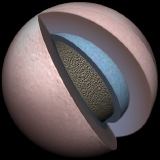 Cross-section through Pluto. |
|
| More about the formation and interior of Pluto | |
| An icy surface | |
| No spacecraft have imaged Pluto's surface. The best view was obtained by the Hubble Space Telescope, which showed that Pluto's surface has the second highest contrast in the Solar System. (The highest is possessed by Saturn's moon Iapetus.) There is doubt about the chemical composition of Pluto's surface, but the bright areas may consist of nitrogen ice, methane and carbon monoxide. | |
 Hubble Space Telescope view of Pluto's surface. |
|
| More about the surface of Pluto | |
| Seasonal variations | |
| The average temperature on Pluto's surface is 50K, or about -220oC. With a planet so remote, orbiting at a distance so far, it seems unlikely that Pluto should have seasons. Nevertheless, the large difference between perihelion and aphelion distances means there is a significant difference in incoming solar radiation. Pluto reached perihelion in 1989, and so is now experiencing summer. Temperatures are therefore higher, and are most probably nearer -210oC. | |
| This results in the generation of an atmosphere - the bright areas on Pluto start to evaporate. The opposite happens during Pluto's winter, when the atmosphere freezes and is deposited back on the surface. This behaviour is similar to the comets , and is possibly a clue to Pluto's origin. | |
| Pluto's moon | |
| Pluto has one moon, Charon. Charon is named after the Greek mythological boatman who ferried the dead across the River Styx to Pluto's underworld. Charon is unusual, in that it is similar in size to its parent planet. That is, Pluto and Charon are more like a double planet, or double moon. Charon does not orbit Pluto, rather, Pluto and Charon orbit each other around a common centre of gravity. | |
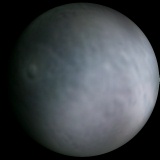 Pluto's moon Charon. |
|
| A lucky discovery | |
| Pluto was discovered by Clyde Tombaugh in 1930 as a result of mathematical prediction, and after Percival Lowell's long and fruitless search. The discovery may have been pure luck, as the mathematical prediction contained errors. | |
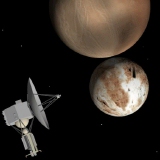 Artist's concept of the proposed Pluto Express mission visiting the Pluto - Charon system |
|
| More about the discovery and exploration of Pluto | |
|
|
|